Patents
Suntan Suzy Doll
Suntan Suzy was a doll that would develop a tan if you put her in the sunlight. Back in the shade, her tan would fade. She came on the market in 1962, but lasted only one season. As far as I can tell, she was the only doll that has ever had the ability to tan.
Arizona Republic - Nov 23, 1962

image source: worthpoint
The chemistry responsible for producing the tanning effect is described in Patent No. 2,921,407 (Jan 19, 1960) – “Simulating Sunburning Toy Dolls and Figurines”:
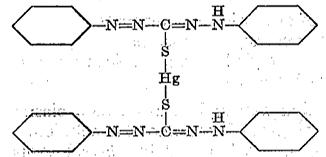
1550 grams of a high molecular weight polyvinyl chloride polymer, in powdered form, were dispersed in this solution by stirring for ten to fifteen minutes. The latter material was specifically Bakelite Company QYNV polymer. Thus a plastisol formulation containing the phototropic dye dissolved in the liquid dioctyl phthalate (plasticizer phase) was obtained. About 120 grams of this plastisol formulation were then poured into a two piece steel mold, this having its inner surface previously coated with a silicone oil release film. This was then placed in an oven at 140 degrees centigrade and held at this temperature for eight minutes to allow solution of the polyvinyl chloride polymer phase. The mold and contents were then removed from the oven, cooled to room temperature, and the now solid form of the doll figure removed.
The figure thus produced was transparent and red in color. Upon exposure to sunlight a progressive darkening to a brown, then blue-black color occurred during a period of about three to four minutes, simulating a “sunburning” effect. When the doll was shielded from the sun a return to the original color took place, being visually complete after a period of eight to ten minutes. This action was repeatable with no detectable change in functional characteristics being noted after several dozen cycles.
It seems like an interesting gimmick for a doll. Curious it never caught on.
Posted By: Alex - Fri Feb 07, 2020 -
Comments (3)
Category: Inventions, Patents, Toys, 1960s
Shave-O-Mat
Harry Thalheim believed that “a need has existed for a long time for a shaving emporium where people may shave cheaply and rapidly at all hours of the day and night.” So, in 1964 he patented the Shave-O-Mat (US Patent No. 3,120,886). It was a coin-operated shave-yourself establishment, open 24 hours a day.Did this address some kind of market need in the 1960s? Were there men who, in the middle of the night, really wanted to shave but couldn’t?
I'm guessing not, because, as far as I can tell, Thalheim's Shave-O-Mat never opened.
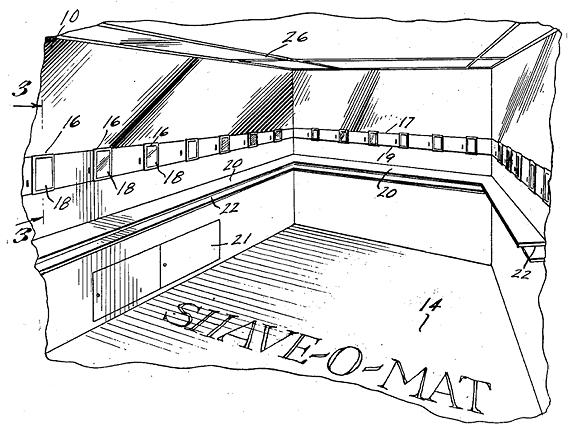
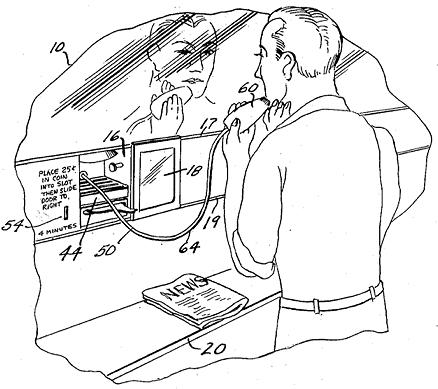
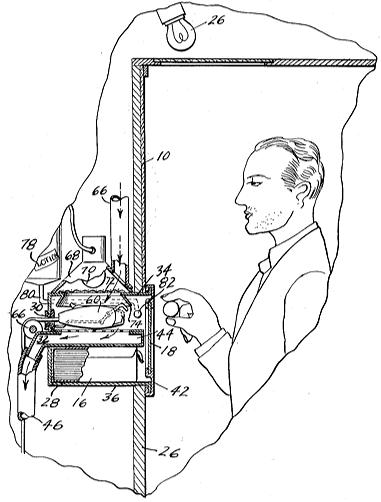
Posted By: Alex - Sun Feb 02, 2020 -
Comments (0)
Category: Inventions, Patents, 1960s, Hair and Hairstyling
Diapers with pistol holsters
Patented by Harriet Y. Clough of Meadville, Pennsylvania in 1958.
Posted By: Alex - Sun Jan 26, 2020 -
Comments (0)
Category: Babies, Guns, Inventions, Patents
The Beautiful Beauty Mask
Patented in 1954 by Ann S.V. Mann of Petersburg, Virginia.It functioned like any other beauty mask. Its primary difference, claimed Mann, was that her mask had the outer appearance of a "strikingly beautiful woman":
The exterior surface of the plastic film body 5 is painted or otherwise decorated to create eyebrows, lashes, nose and mouth lines, etc., so designed as to give the facial appearance of a strikingly beautiful woman. This artistic treatment is an important feature of the invention. Beauty is accentuated in every way possible in all phases of the invention.
Due to the uncanny valley effect, she may actually have ended up creating something that looked more grotesque than a regular mask.

Posted By: Alex - Sun Jan 19, 2020 -
Comments (2)
Category: Beauty, Ugliness and Other Aesthetic Issues, Inventions, Patents, 1950s
Cow burgers and hot dogs
In 1950, Rodney Graves of Arizona patented cow-shaped burger patties. However, he missed an opportunity by not also patenting a cow-shaped bun.
Edward Kiwala of Chicago didn't make a similar mistake when, in 1969, he patented a dog-shaped hot dog (or, at least, a hot dog with four legs like a dog). He also patented the accompanying bun.

Posted By: Alex - Sat Jan 11, 2020 -
Comments (2)
Category: Food, Inventions, Patents
Immersion in sprinkles
Just a few days ago, on Dec 24, 2019, Maryellis Bunn of New York, NY received patent no. 10,513,862 B2 for a “system, method, and apparatus for simulating immersion in a confection.” The specific confection she had in mind was candy sprinkles. Although the patent extends to include Hershey’s kisses and popcorn.In other words, what she’s patented is the idea of a pool full of fake sprinkles, which people can immerse themselves in.


This makes more sense once you find out that Bunn is the founder of the Museum of Ice Cream, and apparently one of the activities you can do, if you visit her museum (in either New York or San Francisco), is swim in a pool of fake sprinkles. See the video below.
Bunn's Museum of Ice Cream business is reportedly worth around $200 million, and she only started it in 2016. So, while some are mocking her sprinkle-immersion patent as frivolous, she's laughing all the way to the bank.
Posted By: Alex - Wed Jan 08, 2020 -
Comments (3)
Category: Business, Inventions, Patents, Candy
The Man Can
Its formal name was the “man-carried auto-navigation device,” but it went by the nickname “Man Can.” The Martin-Marietta Corporation received patent no. 3,355,942 for it in 1967.It was a device designed to help soldiers avoid getting lost. The patent offered this description:

It combined a compass and a pedometer. A GI would record his initial location on a map, and then the device would track his footsteps and the directions in which he turned. When he was done walking, the device would tell him his new coordinates.
A key feature of the device was that it didn't use any battery power. So the GIs would never need to worry about it running out of juice. It operated via a bellows located in the heel of the GI's shoe.
I can't find any follow-up reports about how well this gadget worked. Apparently not well enough to warrant its adoption by the army. But it was an interesting concept.

Allentown Morning Call - Dec 11, 1967
Posted By: Alex - Sun Jan 05, 2020 -
Comments (4)
Category: Geography and Maps, Inventions, Patents, Military, Technology, 1960s
Shaving with X-rays
It wasn't long after the discovery of x-rays, that people realized they could be used to remove body hair. In 1899, the American X-Ray Journal noted the "epilating properties of the X-Rays," and suggested that hair removal might be a profitable side-business for x-ray technicians.However, as far as I can tell, it wasn't until 1945 that anyone got around to patenting the idea of x-ray hair removal. The patent was granted to Violet Arnold of Detroit. Columnist Frederick Othman wrote about it in a Dec 1945 column:
Miss Arnold's shave consists of two X-ray treatments of five to ten minutes each with the rays going through an aluminum plate before they hit the whiskers. That makes 'em curl up. Then she attacks the wilted whiskers nine more times in five weeks with rays going through aluminum and a bottle of water, too.
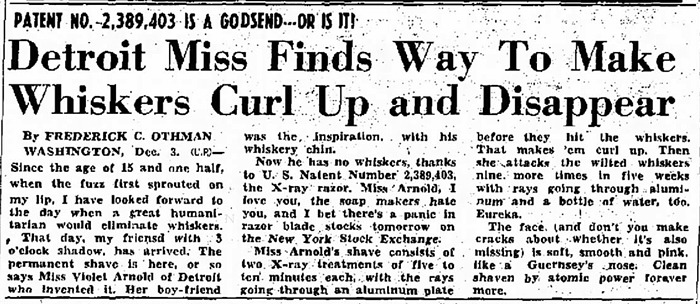
Amarillo Globe Times - Dec 3, 1945
The X-ray razor never caught on, probably because of the risk of serious, disfiguring burns. However, the idea lingered on in popular culture for a few years and was featured in several ad campaigns.

Crowley Post-Signal - Dec 12, 1952

Washington Court House Record-Herals - Jan 6, 1953
Posted By: Alex - Sun Dec 29, 2019 -
Comments (6)
Category: Inventions, Patents, Technology, 1940s
Fly-Operated Turtle
Patent No. 1,591,905, granted to Oscar C. Williams of San Diego, CA in 1926, described this curious device.It was a toy turtle. Its body was made of wood or aluminum, while the head, legs, and tail were made from lightweight cork. The user was supposed to insert several flies into the hollow body of the turtle. Their agitations once inside, as they sought to escape, would then cause the movable parts of the turtle to wag from side to side, as if the creature was alive.
I can see several drawbacks. First, you would have to catch some flies and maneuver them (alive) into the turtle. This was done by squeezing them through the leg hole. Handling a fly in this way seems like it could be a challenge.
And once in there, I imagine you'd have to wait until the flies died to get them back out. So, essentially, it was a fly torture device.

Posted By: Alex - Sun Dec 22, 2019 -
Comments (4)
Category: Insects and Spiders, Inventions, Patents, Toys, 1920s
Mama Robot Device
In 2017, patent number KR20170003315A was granted to a Korean inventor for a "Mama Robot Device". The inventor's name is only given in Korean, so I'm not sure what it is, but Google translates it as Jeong In-pil.The Mama Robot is creepy in many ways. As far as I can tell, it's a device that allows children to punish themselves when they know they've been naughty but their parents are away.
The child is able to decide how many lashes with a cane they deserve, and the Mama Robot will then deliver the punishment. As it does so, the prerecorded voice of the parent will admonish the child, but simultaneously the Mama Robot will weep "such that the sad feelings of the parent punishing are conveyed to the child."
A camera inside Mama Robot will record the entire event and then send the video to the parent's phone, as proof that punishment has been served.
I wonder, how many years of therapy would it take for a child to recover from having Mama Robot installed in their home?

Posted By: Alex - Sun Dec 15, 2019 -
Comments (6)
Category: Inventions, Patents, Robots, Parents

| Who We Are |
|---|
| Alex Boese Alex is the creator and curator of the Museum of Hoaxes. He's also the author of various weird, non-fiction, science-themed books such as Elephants on Acid and Psychedelic Apes. Paul Di Filippo Paul has been paid to put weird ideas into fictional form for over thirty years, in his career as a noted science fiction writer. He has recently begun blogging on many curious topics with three fellow writers at The Inferior 4+1. Contact Us |




